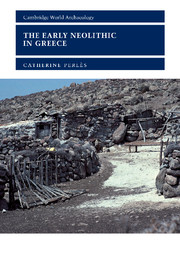Book contents
- Frontmatter
- Contents
- List of figures
- List of tables
- Acknowledgements
- Introduction
- 1 The land and its resources: the geographic context
- 2 The Mesolithic background
- 3 The introduction of farming: local processes, diffusion or colonization?
- 4 Foreign colonists: where from?
- 5 The earliest Neolithic deposits: ‘aceramic’, ‘pre-pottery’ or ‘ceramic’?
- 6 The spread of the Early Neolithic in Greece: chronological and geographical aspects
- 7 A case study in Early Neolithic settlement patterns: eastern Thessaly
- 8 Early Neolithic subsistence economy: the domestic and the wild
- 9 The Early Neolithic village
- 10 Craft specialization: the contrasting cases of chipped-stone tools, pottery and ornaments
- 11 A variety of daily crafts
- 12 Ritual interaction? The miniature world of ‘dolls or deities’
- 13 Interacting with the dead: from the disposal of the body to funerary rituals
- 14 Interactions among the living
- Conclusion
- Bibliography
- Index
3 - The introduction of farming: local processes, diffusion or colonization?
Published online by Cambridge University Press: 18 December 2009
- Frontmatter
- Contents
- List of figures
- List of tables
- Acknowledgements
- Introduction
- 1 The land and its resources: the geographic context
- 2 The Mesolithic background
- 3 The introduction of farming: local processes, diffusion or colonization?
- 4 Foreign colonists: where from?
- 5 The earliest Neolithic deposits: ‘aceramic’, ‘pre-pottery’ or ‘ceramic’?
- 6 The spread of the Early Neolithic in Greece: chronological and geographical aspects
- 7 A case study in Early Neolithic settlement patterns: eastern Thessaly
- 8 Early Neolithic subsistence economy: the domestic and the wild
- 9 The Early Neolithic village
- 10 Craft specialization: the contrasting cases of chipped-stone tools, pottery and ornaments
- 11 A variety of daily crafts
- 12 Ritual interaction? The miniature world of ‘dolls or deities’
- 13 Interacting with the dead: from the disposal of the body to funerary rituals
- 14 Interactions among the living
- Conclusion
- Bibliography
- Index
Summary
Around 7000 BC, marked changes took place: farmers settled in the previously uninhabited alluvial basins, built permanent villages and introduced domestic plants and animals. Theoretically, several processes could account for this radical shift (Barker 1985: 71): a purely autochthonous process, without external contacts; a local process spurred by the acquisition, through exchanges, of foreign goods and techniques (that is, cultural diffusion); the migration into Greece of foreign groups of farmers and herders, solely responsible for the sedentary Neolithic settlements (that is, demic diffusion); or, finally, a mixed process based on interactions between local hunter-gatherers and incoming farmers.
These various possibilities have each been defended by different – or sometimes the same – scholars. However, few nowadays would support the extreme position of Higgs and Jarman (1969, 1972), who considered possible an entirely indigenous shift to a Neolithic economy, based on the local domestication of animal and plant species. Conversely, none of the advocates of a demic diffusion, such as Childe (1957, 1958) or Ammerman and Cavalli-Sforza (1984), denied that some degree of interaction could have taken place between indigenous groups and immigrant farmers. Yet even without calling for extreme models, there remains ample space for widely differing perspectives, depending on the respective roles attributed to local hunter-gatherers or to foreign migrant groups.
Indigenist models and the claims for the local domestication of plants and animals
Autochthonous, or ‘indigenist’ models have progressively gained importance in Greece as in the rest of Europe, in opposition to the purely migrationist views advanced until the end of the 1960s (Weinberg 1970: 570–1).
- Type
- Chapter
- Information
- The Early Neolithic in GreeceThe First Farming Communities in Europe, pp. 38 - 51Publisher: Cambridge University PressPrint publication year: 2001



